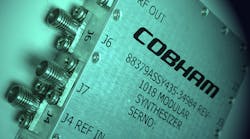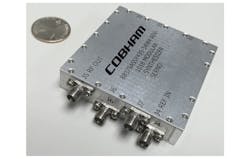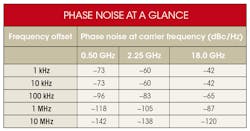Download this article as a .PDF
Signal generation is the start and finish for many electronic defense-oriented systems. High-frequency signals with low noise and high stability are needed for transmit and receive functions, with performance that remains consistent even after the abuse that takes place in rugged military environments. Fortunately, the 435-36105 frequency synthesizer from Cobham Microelectronic Solutions, a member of the company’s 1018 series of signal sources, is built for the field rather than the laboratory.
The signal source covers a frequency range from 0.45 to 18.25 GHz in 10-MHz steps with at least +3 dBm output power across the frequency range. It is built to operate under the conditions of shock, vibration, and temperature typically found in severe military environments. The design is modular, incorporates custom-designed filters, and can be customized if needed. Cobham has a long history of providing optimized solutions for challenging applications.
The compact signal source (see photo) meets the size, weight, and power (SWaP) requirements of most military systems, supplied in a machined housing measuring just 2.6 × 2.6 × 0.6 in. and weighing just 0.25 lb. As with many of the frequency synthesizers designed and developed by Cobham—the former Aeroflex/Comstron—this latest addition to the 1018 series is built for speed, featuring a parallel control interface to facilitate pipelined hopping. This provides better than 250 µs typical switching speed from any start frequency to any stop frequency in the full range. It typically achieves faster switching speed for smaller frequency steps.
While lacking the ultimately low noise levels of laboratory benchtop frequency synthesizers, the 435-36105 synthesizer maintains reasonably low noise with high levels of shock, vibration, and a wide operating temperature range of −40 to +70ºC. The spurious content is −55 dBc from 450 MHz to 12 GHz and −50 dBc from 12 to 18.25 GHz. Subharmonics are −20 dBc throughout the frequency range, while second harmonics are −12 dBc from 450 MHz to 12 GHz and −15 dBc or better from 12 to 18.25 GHz.
The compact synthesizer has an SMA port for connection to an external 10-MHz reference oscillator while maintaining the frequency stability of the external reference. The output power remains within a ±2-dB window when the frequency synthesizer is operated within ±5ºC of the calibration temperature.
As expected for a PLL frequency synthesizer, the absolute phase noise—including the noise of the external reference source—is higher when measured closer to the carrier and for higher carrier frequencies. For example, the phase noise (measured in a 1-Hz bandwidth) is −73 dBc/Hz offset 1 kHz from a 500-MHz carrier, decreasing to −96 dBc/Hz offset 100 kHz from a 500-MHz carrier, and dropping to −142 dBc/Hz offset 10 MHz from the same carrier.
The phase noise degrades with carrier frequency, with phase noise of −60 dBc/Hz offset 1 kHz from the carrier, −83 dBc/Hz offset 100 kHz from the same carrier, and −138 dBc/Hz offset 10 MHz from the same carrier. At 18 GHz, the phase noise is −42 dBc/Hz offset 1 kHz from the carrier, −65 dBc/Hz offset 100 kHz from the carrier, and −120 dBc/Hz offset 10 MHz from the carrier. See the table for more details on phase noise.
The frequency synthesizer is designed for use with a +5 V dc supply (±10%), typically drawing 1.25 A current. It is one example of a diversified product line that includes many of the components required for modern radar and electronic warfare (EW) systems, including integrated frequency converters, switch matrices, and active electronically scanned array antennas (AESAs). One such AESA operates from 8 to 10 GHz with azimuth and elevation scan volumes of ±60 deg. A field-programmable-gate-array (FPGA) controller supports real-time beam forming.
Cobham Microelectronic Solutions, 35 South Service Rd., Plainview, NY 11803; (800) 843-1553, (516) 694-6700



